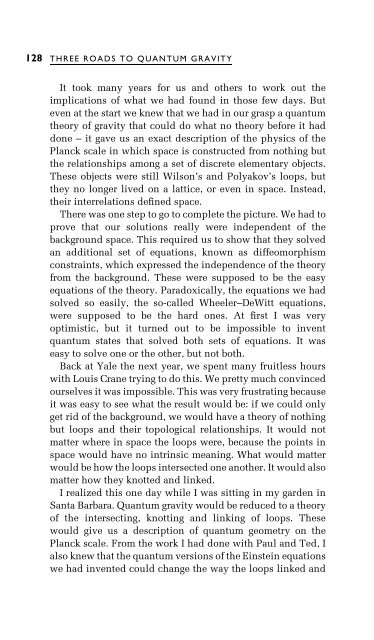Three Roads To Quantum Gravity
Three Roads To Quantum Gravity
Three Roads To Quantum Gravity
You also want an ePaper? Increase the reach of your titles
YUMPU automatically turns print PDFs into web optimized ePapers that Google loves.
128 THREE ROADS TO QUANTUM GRAVITY<br />
It took many years for us and others to work out the<br />
implications of what we had found in those few days. But<br />
even at the start we knew that we had in our grasp a quantum<br />
theory of gravity that could do what no theory before it had<br />
done ± it gave us an exact description of the physics of the<br />
Planck scale in which space is constructed from nothing but<br />
the relationships among a set of discrete elementary objects.<br />
These objects were still Wilson's and Polyakov's loops, but<br />
they no longer lived on a lattice, or even in space. Instead,<br />
their interrelations de®ned space.<br />
There was one step to go to complete the picture. We had to<br />
prove that our solutions really were independent of the<br />
background space. This required us to show that they solved<br />
an additional set of equations, known as diffeomorphism<br />
constraints, which expressed the independence of the theory<br />
from the background. These were supposed to be the easy<br />
equations of the theory. Paradoxically, the equations we had<br />
solved so easily, the so-called Wheeler±DeWitt equations,<br />
were supposed to be the hard ones. At ®rst I was very<br />
optimistic, but it turned out to be impossible to invent<br />
quantum states that solved both sets of equations. It was<br />
easy to solve one or the other, but not both.<br />
Back at Yale the next year, we spent many fruitless hours<br />
with Louis Crane trying to do this. We pretty much convinced<br />
ourselves it was impossible. This was very frustrating because<br />
it was easy to see what the result would be: if we could only<br />
get rid of the background, we would have a theory of nothing<br />
but loops and their topological relationships. It would not<br />
matter where in space the loops were, because the points in<br />
space would have no intrinsic meaning. What would matter<br />
would be how the loops intersected one another. It would also<br />
matter how they knotted and linked.<br />
I realized this one day while I was sitting in my garden in<br />
Santa Barbara. <strong>Quantum</strong> gravity would be reduced to a theory<br />
of the intersecting, knotting and linking of loops. These<br />
would give us a description of quantum geometry on the<br />
Planck scale. From the work I had done with Paul and Ted, I<br />
also knew that the quantum versions of the Einstein equations<br />
we had invented could change the way the loops linked and



![arXiv:1001.0993v1 [hep-ph] 6 Jan 2010](https://img.yumpu.com/51282177/1/190x245/arxiv10010993v1-hep-ph-6-jan-2010.jpg?quality=85)


![arXiv:1008.3907v2 [astro-ph.CO] 1 Nov 2011](https://img.yumpu.com/48909562/1/190x245/arxiv10083907v2-astro-phco-1-nov-2011.jpg?quality=85)








![arXiv:1002.4928v1 [gr-qc] 26 Feb 2010](https://img.yumpu.com/41209516/1/190x245/arxiv10024928v1-gr-qc-26-feb-2010.jpg?quality=85)
![arXiv:1206.2653v1 [astro-ph.CO] 12 Jun 2012](https://img.yumpu.com/39510078/1/190x245/arxiv12062653v1-astro-phco-12-jun-2012.jpg?quality=85)
